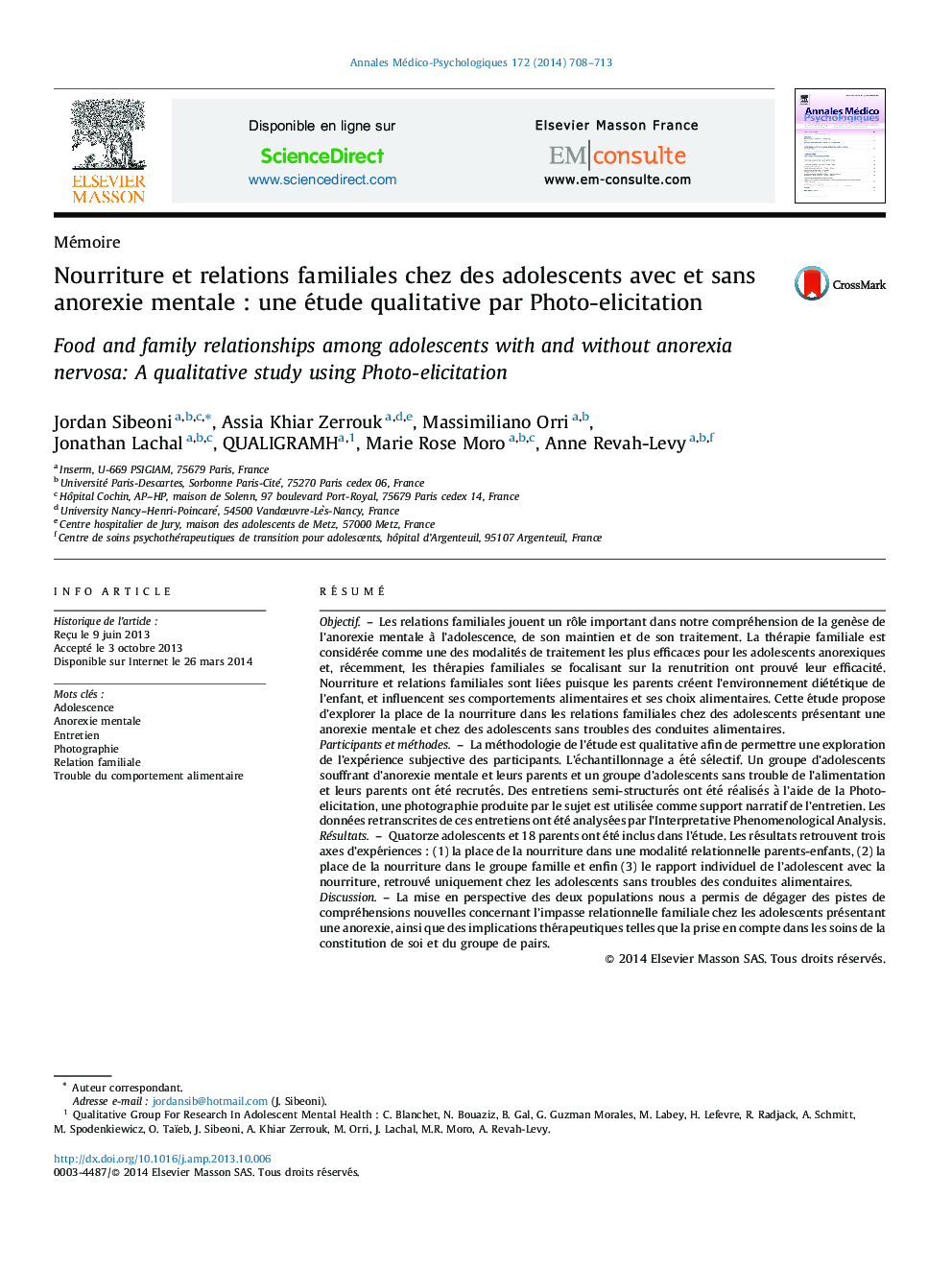| کد مقاله | کد نشریه | سال انتشار | مقاله انگلیسی | نسخه تمام متن |
|---|---|---|---|---|
| 312398 | 534213 | 2014 | 6 صفحه PDF | دانلود رایگان |

RésuméObjectifLes relations familiales jouent un rôle important dans notre compréhension de la genèse de l’anorexie mentale à l’adolescence, de son maintien et de son traitement. La thérapie familiale est considérée comme une des modalités de traitement les plus efficaces pour les adolescents anorexiques et, récemment, les thérapies familiales se focalisant sur la renutrition ont prouvé leur efficacité. Nourriture et relations familiales sont liées puisque les parents créent l’environnement diététique de l’enfant, et influencent ses comportements alimentaires et ses choix alimentaires. Cette étude propose d’explorer la place de la nourriture dans les relations familiales chez des adolescents présentant une anorexie mentale et chez des adolescents sans troubles des conduites alimentaires.Participants et méthodesLa méthodologie de l’étude est qualitative afin de permettre une exploration de l’expérience subjective des participants. L’échantillonnage a été sélectif. Un groupe d’adolescents souffrant d’anorexie mentale et leurs parents et un groupe d’adolescents sans trouble de l’alimentation et leurs parents ont été recrutés. Des entretiens semi-structurés ont été réalisés à l’aide de la Photo-elicitation, une photographie produite par le sujet est utilisée comme support narratif de l’entretien. Les données retranscrites de ces entretiens ont été analysées par l’Interpretative Phenomenological Analysis.RésultatsQuatorze adolescents et 18 parents ont été inclus dans l’étude. Les résultats retrouvent trois axes d’expériences : (1) la place de la nourriture dans une modalité relationnelle parents-enfants, (2) la place de la nourriture dans le groupe famille et enfin (3) le rapport individuel de l’adolescent avec la nourriture, retrouvé uniquement chez les adolescents sans troubles des conduites alimentaires.DiscussionLa mise en perspective des deux populations nous a permis de dégager des pistes de compréhensions nouvelles concernant l’impasse relationnelle familiale chez les adolescents présentant une anorexie, ainsi que des implications thérapeutiques telles que la prise en compte dans les soins de la constitution de soi et du groupe de pairs.
ObjectivesFamily relationships have an important role in our understanding of the genesis of adolescent Anorexia Nervosa, in its maintenance, and especially in the caring process. Family therapy is considered as the most effective treatment modalities in adolescent anorexia nervosa and nowadays family renourishment therapies such as family based treatment have shown evidence base. Food and family relationships are bound since parents create the eating and dietary environment of the child, and influence dietary behaviors and food choices. This study aims to explore the place of food in family relationships among adolescents with Anorexia Nervosa and adolescents without any eating disorder.Materials and methodsA qualitative exploratory design was employed in order to explore the subjective experience of participants. This study relied on purposive sampling. A group of adolescents with Anorexia Nervosa and their parents and a group of adolescents without any eating disorder and their parents were recruited. Interpretive phenomenological analysis was applied to semi-structured interviews using photo-elicitation to support participant's narratives.ResultsFourteen adolescents and eighteen parents were included in the study. Emerging themes were gathered and ordered into three axes of experience that described three different relational patterns regarding food and family: (1) the place of food in a parent–child relational mode including 3 themes: Food so as to be like/unlike, Food and relational control and Food and proof of love, (2) the place of food in the family group including 4 themes Food and cohesion vs. conflict, The meal as a “photograph” of family functioning, Food, cohesion and relational interplay and Food, transmission and family history, and (3) the individual relationship entertained by the adolescent with food, found solely among adolescents without any eating disorder.ConclusionsThe contrasts between these two populations enabled new insights regarding the family relational deadlock among adolescents with anorexia nervosa and the issue of self in this disease. The absence of an individual relationship among adolescents with anorexia nervosa provided the idea of integrating the human agency concept into care.
Journal: Annales Médico-psychologiques, revue psychiatrique - Volume 172, Issue 9, November 2014, Pages 708–713